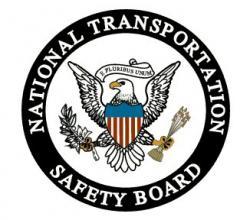Sat, Mar 01, 2008
Cites Possible Maintenance Error In Connecting Antiskid
Sensors
 In its continuing investigation of
an incident in which a United Airlines Airbus A320 departed the
runway during landing at Wyoming's Jackson Hole
Airport on the evening of February 25, the
National Transportation Safety Board (NTSB) has developed the
following factual information during its on-scene
investigation.
In its continuing investigation of
an incident in which a United Airlines Airbus A320 departed the
runway during landing at Wyoming's Jackson Hole
Airport on the evening of February 25, the
National Transportation Safety Board (NTSB) has developed the
following factual information during its on-scene
investigation.
Investigators with the safety board have determined the airplane
came to rest 116 feet past the end of the runway, and 140 feet to
the right of the runway centerline. A heavy skid mark was found on
the runway associated with the inboard tire of the left main
landing gear. This tire was found deflated and showed wear
consistent with a skid. Upon exiting the runway, both engines
ingested snow and sustained internal damage. The aircraft itself
was not substantially damaged.
Examination of the left main landing gear brakes revealed that
the inboard and outboard wheel speed tachometer wires were
cross-connected. Such a configuration would be likely to cause the
antiskid system to use the inboard wheel speed to control the
outboard braking, and vice versa. In such a situation, it would be
likely that when the inboard tire began to skid, the antiskid
system would release the pressure on the outboard brake instead of
the inboard brake.
Examination of maintenance records indicated that both main landing
gear units were replaced on the incident airplane in early February
2008. The Safety Board is also investigating another United A320
incident with similar circumstances that occurred on October 9,
2007.
Another area of the investigation is the inoperability of one of
the emergency evacuation slides. The slide at the front left door
deployed when the door was opened during the evacuation but did not
inflate. The manufacturer of the slide will assist the NTSB in its
investigation of the cause of the failure.
Information obtained from the flight data recorder (FDR) and the
cockpit voice recorder (CVR) is being analyzed at the Safety
Board's laboratory in Washington.
Investigators are continuing to gather factual information in
aircraft performance, human factors and other areas.
More News
He Attempted To Restart The Engine Three Times. On The Third Restart Attempt, He Noticed That Flames Were Coming Out From The Right Wing Near The Fuel Cap Analysis: The pilot repor>[...]
Make Sure You NEVER Miss A New Story From Aero-News Network Do you ever feel like you never see posts from a certain person or page on Facebook or Instagram? Here’s how you c>[...]
From 2009 (YouTube Edition): Leading Air Show Performers Give Their Best Advice for Newcomers On December 6th through December 9th, the Paris Las Vegas Hotel hosted over 1,500 air >[...]
Aero Linx: NASA ASRS ASRS captures confidential reports, analyzes the resulting aviation safety data, and disseminates vital information to the aviation community. The ASRS is an i>[...]
“For our inaugural Pylon Racing Seminar in Roswell, we were thrilled to certify 60 pilots across our six closed-course pylon race classes. Not only did this year’s PRS >[...]
 NTSB Final Report: Rutan Long-EZ
NTSB Final Report: Rutan Long-EZ ANN FAQ: Turn On Post Notifications
ANN FAQ: Turn On Post Notifications Classic Aero-TV: ICAS Perspectives - Advice for New Air Show Performers
Classic Aero-TV: ICAS Perspectives - Advice for New Air Show Performers ANN's Daily Aero-Linx (06.28.25)
ANN's Daily Aero-Linx (06.28.25) Aero-News: Quote of the Day (06.28.25)
Aero-News: Quote of the Day (06.28.25)



